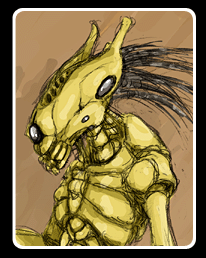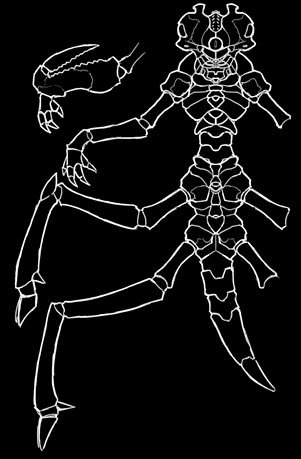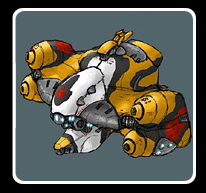|
Data File Updated: Sunday, July 22, 2018 Origins and Empire
When the fall of the Soia galactic system isolated and devastated Empire, the Tizik-tik civilization became vulnerable to their nomadic Hal-tik rivals. In the aftermath of the orbital bombardments of the Soia Cataclysm, the Hal-tik immediately overran a large portion of the now-ruined Tizik-tik cities. While the Hal-tik barbarians picked through the ruins, a portion of Tizik-tik technological society reconstituted itself and began to rebuild. What followed was a millennia-long age of global chaos and warfare, in which the increasingly sophisticated Hal-tik relentlessly gnawed at the frontiers of a shrinking Tizik-tik civilization. Initially, even the post-Cataclysm Tizik-tik had little trouble repelling the raids of the still-primitive Hal-tik barbarians. But gradually the Hal-tik co-opted elements of Tizik-tik culture and technology, especially techniques for industry, weaponry and genetic manipulation. When at length the Hal-tik finally trod atop the ruins of the last Tizik-tik city, they had been changed almost beyond recognition, from nomadic traditionalists into living engines of industry and warfare. And they were now masters of a world depleted by uncounted generations of unrestricted conflict and ruinous environmental exploitation. Information on early Umiak space colonization is sketchy, but it seems likely that it was driven by a need to find resources outside their ravaged homeworld. Confronted with a universe of heavier-gravity worlds and the alien races that inhabited them, the Umiak continued to use the genetic and cybernetic alteration techniques learned from the Tizik-tik to adapt themselves to the needs of the moment. The details of their first contacts with other alien civilizations are not known, but it seems that they were all ultimately absorbed into the growing Umiak sphere of influence. The current Umiak Hierarchy is believed to be larger than the empire of the Loroi, and though some of the races may have joined voluntarily, it seems that many were annexed by force. For the most part, clients of the Hierarchy are allowed little in the way of self-determination, and the Umiak impose oppressive and sometimes ruinous demands on their subjects' labor and natural resources. A heavily restricted society even before the war, since the start of hostilities with the Loroi, most members of the Hierarchy have been completely out of contact with any external entities. See main article: Races of the Umiak Hierarchy. Biology
To
describe Umiak biology succinctly is a challenging task, because
the configuration of individual specimens varies so widely. In
addition to the natural diversity that comes from being derived
from three distinct sub-species, over the millennia the Umiak
have undergone extensive genetic engineering programs and
cybernetic alterations in the attempt to overcome the physical
limitations that are a result of evolution on a low-gravity
planet. Some Umiak, who still
live on low-gravity worlds or aboard the gravity-controlled
environments of starships and space habitats, are still very
similar in form to the state in which they originally evolved,
but many more have been extensively genetically modified to suit
the environments and tasks to which they have been assigned.
Those employed in work on heavier-gravity planets and
particularly those in the infantry have been specially bred for
these tasks, are much heavier and stronger, and are more likely
to have been cybernetically modified, sometimes quite
extensively, to the point of being almost unrecognizable as the
same species. The large valentine-shaped skull sports seven eyes: one large primary eye in the center above the mandibles, two secondary eyes on the sides of the head, and four small ocelli: two each on the bony ridges that jut from the "cheeks." The mouth consists of two pairs of lateral mandibles and one lower ventral mandible, enclosing a fibrous tongue. Breathing spiracles are positioned at the top of the skull, crowned by short horn-like structures that vary by individual and are apparently decorative. At the back of the skull above where it joins the neck sprouts a mat of hairy spines, which are usually damp and are used in temperature regulation. These damp spines are a primary source of an Umiak's very strong odor.
Umiak circulatory fluid is black and viscous. The Umiak
exoskeleton is built of a living bone-like material with a
hardened exterior coating. The exoskeleton grows with the
individual, eliminating the necessity of molting; the hard
exterior layer splits at multiple points and fills in with new
material. Umiak carapaces range in color from
pale tan, through yellow, to dark red, darkening as the individual
ages. The
tufts of hair at the joints range from brown to black (sometimes
graying with age). Umiak become aged between 60 and 80 years old
and usually die soon thereafter; medical technology can extend
lives indefinitely, but this is a rare step. Only a truly
remarkable and important Umiak individual could be persuaded to abandon its
ingrained humility and seek to live past its normal lifespan.
Umiak are renowned for their tirelessness; activity in low
gravity requires relatively little energy, and shipboard Umiak
routinely go for extended periods (of up to several weeks)
without sleep. Those Umiak stationed planetside often require
much more rest to allow them to cope with the stresses of higher
gravity. I've heard that one of the reasons that insects on earth aren't on average bigger has something to do with the ratio of exoskeleton weight to muscle power. Meaning that the bigger the exoskeleton, the more muscle power required to move it, and that on earth, the bugs have pretty much reached the functional limits of that dynamic. The chief size limitation on arthropods is due to their primitive oxygen delivery system; they have trachea that must reach into every part of the body to deliver oxygen, and as the body size increases so does the proportion of space taken up by the trachea. The giant insects of the Carboniferous era were able to exist because it was a period of much higher atmospheric oxygen density. However, the heavy chitin exoskeleton would also eventually become a limiting factor, both from a weight and structural strength standpoint. As one would expect of "higher animals" capable of developing intelligence, Umiak are warm-blooded and have sophisticated circulatory and respiratory systems similar to mammals. Their external skeletons are stronger than an insect's chitin, but they still run into serious weight problems as they get larger, as a giant insect might. But because they evolved on a world with only one-third of Earth's gravity, the weight of the Umiak exoskeleton isn't a problem, and they are agile, swift creatures in their own environment. On a world with Earth-normal gravity, an unmodified Umiak can barely walk, which is one of the reasons why they rely so heavily on biological modification and mechanical augmentation. SocietyUmiak philosophy emphasizes duty, toil, modesty, self-sufficiency, patience, frugality, charity and the subordination of the self to the greater whole. Personal honor is a low priority. As individuals, Umiak are said to be exceedingly polite and well-mannered, overflowing with humility and zeal for the common welfare. As a group, the Umiak are paranoid, intolerant, aggressive and despotic. Though intelligent and highly technologically advanced, the Umiak are nevertheless not terribly innovative. Many of their technologies are copied or stolen from their clients or neighbors, but once such technology is assimilated, the Umiak are masters at putting it to work for them. Umiak are efficiency experts, and tireless, detail-oriented workers. Umiak do not appear to have family units or form pair bonds; an individual's social ties are to its co-workers, its community, and to the state. Umiak individuals are referred to by their job title, appended with a unique identifier that is essentially a serial number. The various local sub-cultures are likely to be very diverse in their rituals and practices. Drums and tribal totems are commonly found aboard destroyed or captured Umiak vessels, but few specifics are known about their ritual observances. Umiak "religion" seems to be more of a philosophy, that is somewhat bleak and nihilistic, that seeks perfection above and beyond the miserable mortal existence. The complexity of Umiak language does lend itself to poetry; I can imagine Umiak crews during off duty hours composing clicking verse reflecting on the brief spark that is life. Economy
Umiak would usually rather manufacture something new than allocate production infrastructure to upgrade or refit something old. Umiak ship crews are individually responsible for maintenance; self-sufficiency with minimal support is considered paramount. Often a ship's crew will include engineers and workers who took part in constructing it. A damaged or malfunctioning Umiak vessel must usually be repaired on the spot by its crew, using whatever resources are at hand, or else it will be cannibalized for spare parts. Although their technology is in some ways superior to that of the Loroi, the Umiak generally do not upgrade older units, leaving them in service until they are destroyed. Often more than half the ships in the assault fleets that the Umiak throw at Loroi lines are outdated and in sub-optimal condition; this is balanced by the fact that such fleets tend to be two to three times the size of an equivalent, carefully maintained Loroi fleet. This philosophy applies not just to Umiak hardware, but to the Umiak individuals themselves. Apparently, when Umiak crews are assigned to a ship, they are assigned permanently, as if they were equipment. See also: Races of the Umiak Hierarchy, Umiak Warship Types, Umiak Language |
![]()
1
2
3
4
5
6
7
8
9
10
11
12
13
14
15
16
17
![]()
18
19
20
21
22
23
24
25
26
27
28
29
30
31
32
33
34
35
36
37
38
39
40
41
42
43
44
45
46
47
48
49
50
51
52
53
54
55
56
57
58
59
60
61
62
63
64
65
66
67
68
69
70
71
72
73
74
75
76
77
78
79-80
81
82
83
84
85
86
87
88
89
90
91
![]()
92
93
94
95
96
97
98
99
100
101
102
103
104
105
106
107
108
109
110
111
112
113
114
115
116
117
118
119
120
121
122
123
124
125
126
127
128
129
130
131
132
133
134
135
136
137
138
139
140
141
142
143
144
145
146
147
148
149
150
151
152
153
154
155
156
157
158
159
160
161
162
163
164
165
166
167
168
169
170
171
172
173
174
175
176
177
178
179
180
181
182
183
184
185
186
187
188
189
190
191
192
193
194
195
196
197
198
199
![]()
200
201
202
203
204
205
206
207
208
209
210
211
212
213
214
215
216
217
218
219
220
221
222
223
224
225
226



 The Umiak have a “use and discard” mentality. They seem
unconcerned about pollution or destruction of environment, perhaps because they do not
themselves have to live on the majority of the heavy-gravity planets they control.
Few outsiders are allowed into those low-G planets that the
Umiak have designated for their own habitation. Though it is rumored that the
Umiak home planet has become
a nightmarish wasteland, some suggest that the Umiak may now take more care with
their own worlds, and leave the ruination to
their subjects.
The Umiak have a “use and discard” mentality. They seem
unconcerned about pollution or destruction of environment, perhaps because they do not
themselves have to live on the majority of the heavy-gravity planets they control.
Few outsiders are allowed into those low-G planets that the
Umiak have designated for their own habitation. Though it is rumored that the
Umiak home planet has become
a nightmarish wasteland, some suggest that the Umiak may now take more care with
their own worlds, and leave the ruination to
their subjects.